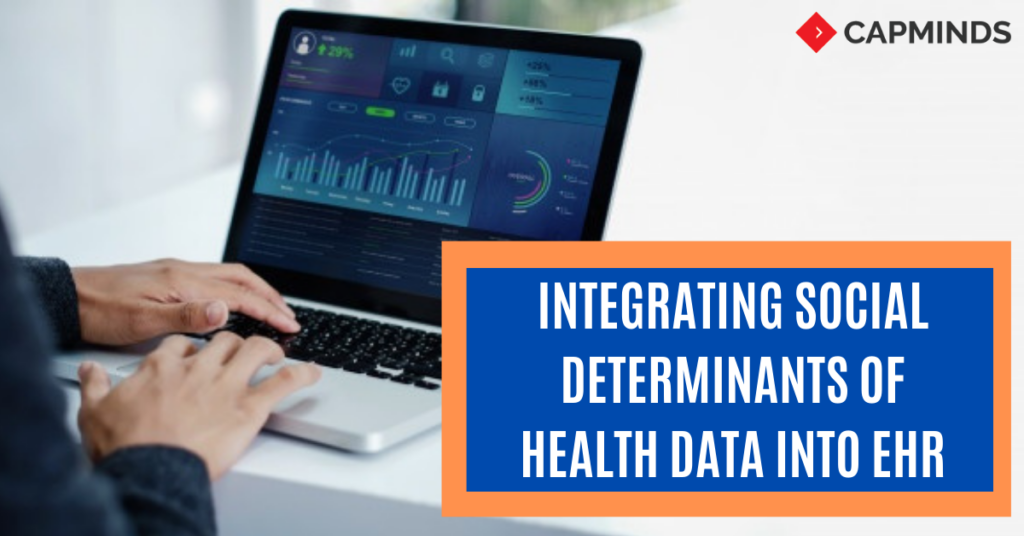Integrating Social Determinants Of Health Data Into EHR
The spread of COVID-19 featured the significance of SDOH data collection making it an important factor to be considered immediately for providers and researchers. Integrating social determinants of health (SDOH) data into the EHR helps healthcare providers and professionals gain insight into COVID-19.
The recent researches on SDOH show that identifying and implementing a patient’s SDOH data into the EHR is very important in finding solutions to particular health issues. Most of the health systems are trying to implement SDOH data into patient health records. But, while implementing they face some issues related to interoperability. So, here is all about integrating social determinants of health data into EHR.
Why
Addressing SDOH Data Is Important?
Addressing
social determinants requires the integration of this information into the EHR.
Otherwise, providers will not be able to use it for clinical decision-making.
It’s now
considered common knowledge that providers need to address a patient’s social
determinants of health. These factors such as an individual’s financial
situation, ability to get healthy food options, and access to reliable
transportation can be more important to an individual’s health outcomes than
the actual clinical care he receives.
Commonly
cited statistics show that clinical care influences just 10 to 20 percent of a
patient’s outcomes, while social determinants of health impact the remainder.
If a patient cannot adhere to his hypertension care plan if the medication is
too expensive for him to buy every month, then outcomes will suffer. Similarly,
outcomes will not improve for an obese patient, if she cannot afford healthy
food options or get to a grocery store miles away from home.
But
providers are often unaware of this information and some have previously felt
it was not their responsibility to address it. Only as the evidence has grown
have providers felt a push to incorporate these non-traditional risk factors into
their clinical decision-making.
How To
Integrate SDOH Data Into EHR?
Providers
can screen for this information in multiple ways: paper questionnaires before a
patient sees the clinician, conversations when discussing treatment options, or
publicly available data sets that give context to where a patient lives and
works. The last option uses data from sources such as the Census or American
Community Survey on neighborhood-level demographic information and links this
to the patient’s home address under the assumption that it is reflective of the
patient’s experiences.
Regardless
of the method of collection, this information needs to be incorporated into a
patient’s medical record for providers to use it for clinical decision-making.
Similar to how a doctor can view a patient’s previous medical diagnosis and use
that information to inform future care, doctors need access to a patient’s
social determinants of health if they are to consider it when providing
treatment options.
However, interoperability, the physical location of this information in the EHR, and a lack of standard codes for this data challenge a provider’s ability to truly understand a patient’s social determinants of health.
To better incorporate this information into the EHR, providers first must determine how to obtain this information and work it into their clinical workflow. Then they need technical assistance to support documentation. But all this will be moot if there is not infrastructure further upstream to support these efforts. Coding standards and guidelines will ensure appropriate referral patterns and reimbursement to make addressing social determinants of health sustainable.
RELATED: ROLE OF INTEROPERABILITY IN CARE COORDINATION
Integration
Into Clinical Workflow
For social
determinants of health to be incorporated into the EHR and, therefore, clinical
decision-making, providers must first capture this information from patients to
understand their risks. This requires a large adjustment of clinical workflow.
Providers
must first select how they are screening for social determinants of health and
which social determinants are addressable.
There is a fine balance between alerting providers to important information and not inundating them with too much information. Figuring out what this looks like for each clinic or hospital requires collaboration between IT and providers to understand what will be most useful in the clinical workflow.
RELATED: HOW TO IMPROVE CLINICAL WORKFLOW:4 COOL TIPS
Technological
Support
There is no
standard location in the EHR to document social determinants of health. But
having a location to document these factors is critical. Providers should have
one standard location to understand a patient’s social needs as they have one
standard location to look at a patient’s blood pressure.
Without this, providers need to either search through the medical record, losing valuable time with patients or repeatedly ask patients screening questions. Otherwise, this information cannot be considered in clinical decision-making.
Building
this into an existing EHR infrastructure can be a challenge for many
organizations. Those with a rigorous IT department can leverage their internal
staff while others might find it beneficial to partner externally with their
EHR vendor to build in the capabilities directly.
So, working closely with the internal or external IT team is critical. Not only will this help set up the infrastructure to document the data, but it will help with external referrals as well.
RELATED: THE ULTIMATE GUIDE TO QUALITY EHR DOCUMENTATION
Coding And
Standards
While
organizations can build a workflow and infrastructure that incorporates
patients’ social determinants of health internally, upstream factors in the
larger healthcare system must be in place for social determinants of health to
be sustainably addressed.
One of the
biggest factors the industry needs to address is clinical coding. Currently,
there are over 1,000 codes to document screening, assessment, diagnosis,
treatment, and intervention of social health-related clinical activities. But
there is a gap in medical vocabulary and these codes do not encompass every
social determinant of health a patient might have.
Standard
reimbursement would promote better screening practices and coding, making
addressing social determinants of health more sustainable. Right now, providers
are on their own. Each clinic, hospital, or health system is doing things
uniquely. But finding a place for social determinants of health information in
the EHR using codes and standards could help providers address some of the most
pressing issues for their patients.
Final
Thoughts
In today’s healthcare system, the social determinants of health data profoundly impact health. So the providers should focus more on the social factors that might increase their patient’s health risks.
Empowering healthcare providers to handily screen for social determinants of health and utilize that data for the purpose of care will make tending to a patient’s food uncertainty as smoothed out as tending to a patient’s diabetes. This will place the same importance on the patient’s social determinants of health as their traditional clinical care.

 Author: Pandi Paramasivan
Author: Pandi Paramasivan
![The Guide to Custom EHR Application Development [Features + Benefits]](https://www.capminds.com/wp-content/uploads/2024/11/Blog-Featured-Images-2024-11-25T110915.039-400x250.jpg)

